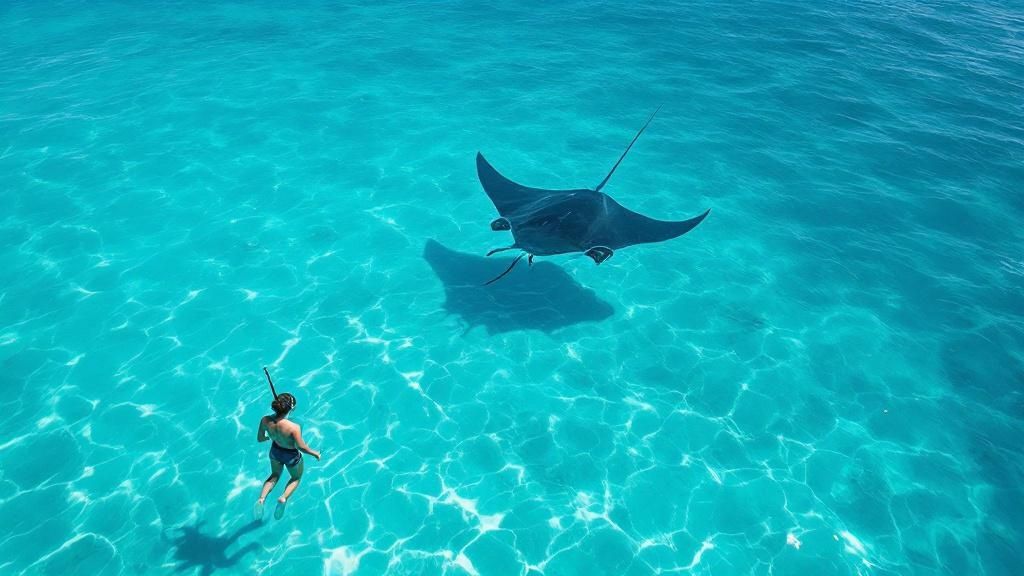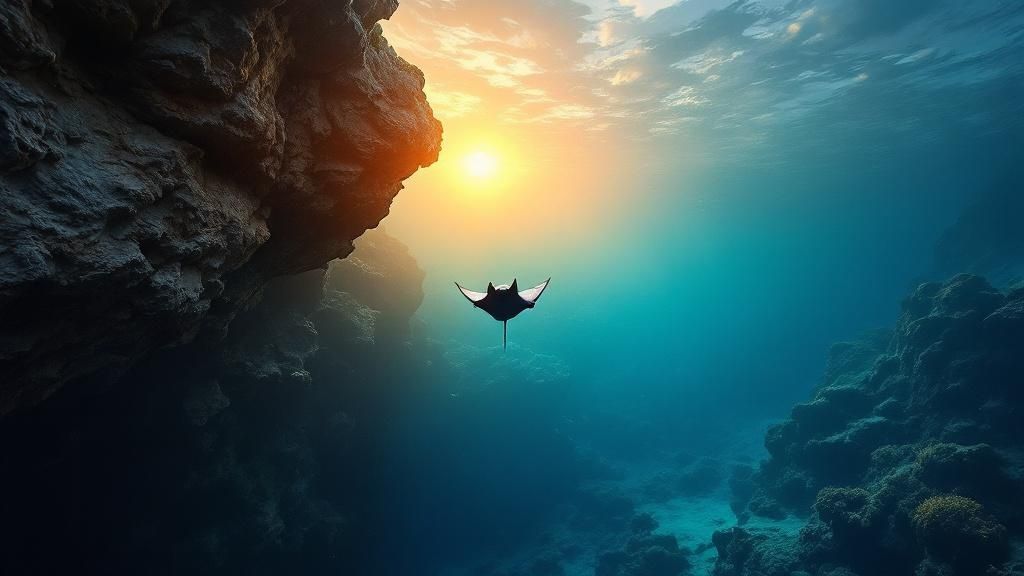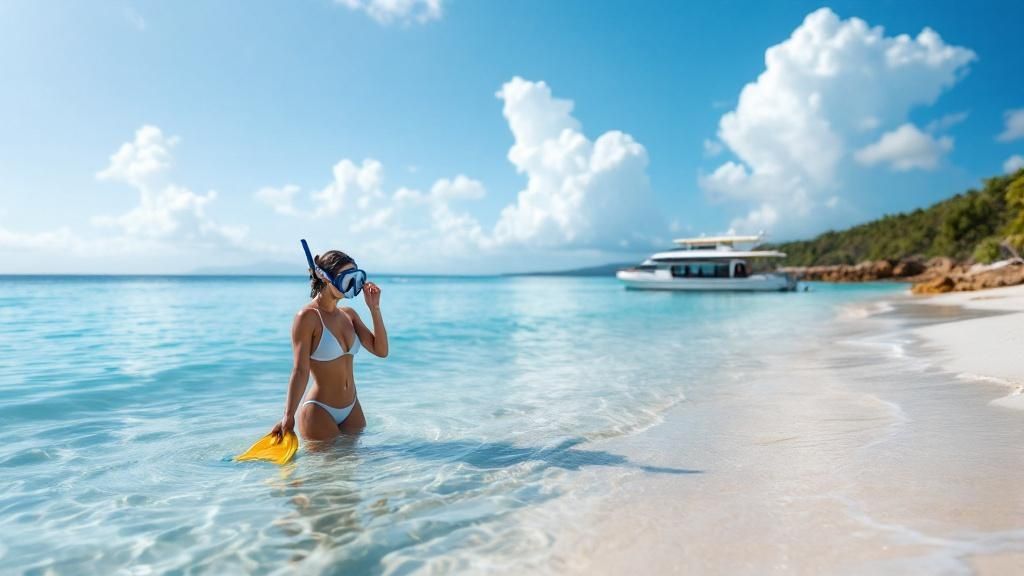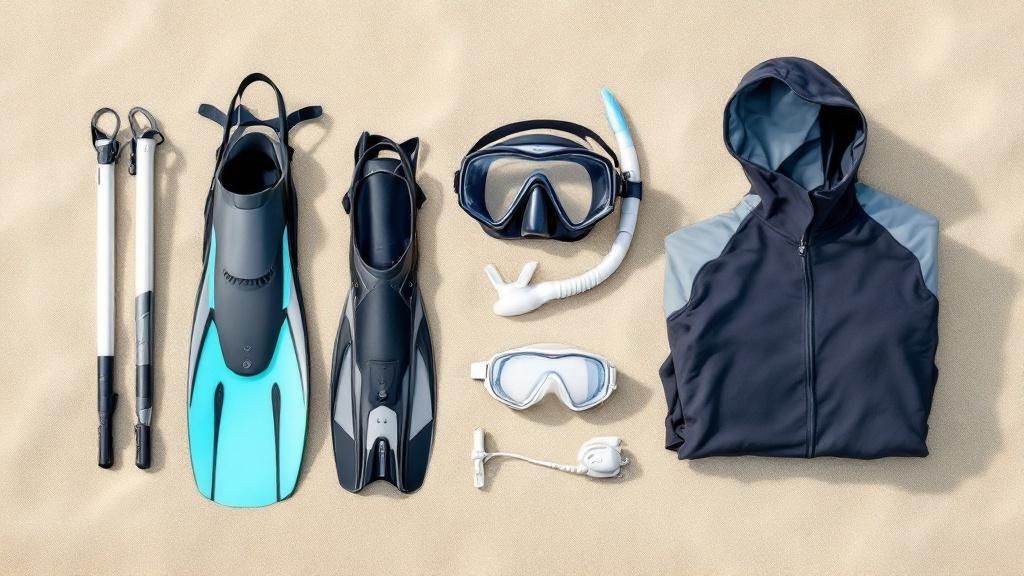Manta Ray Snorkel Kona: Top Hawaii Marine Adventure
- Byron
- Jun 3
- 12 min read
Why Kona Delivers The World's Most Reliable Manta Ray Encounters

The Big Island of Hawai'i, and the Kona coast in particular, is more than just a beautiful vacation spot. It's a manta ray paradise. But what makes this location so attractive to these gentle giants? The answer is a unique blend of geographical and ecological elements. The island's volcanic foundation has created a distinct underwater environment perfectly suited to the manta ray's way of life.
The Perfect Combination: Volcanoes and Plankton
Volcanic activity has sculpted Kona's coastline, producing deep slopes and nutrient-rich upwellings. These upwellings carry vital nutrients from the ocean depths to the surface. This process encourages the growth of massive plankton blooms. Plankton, which are microscopic organisms, form the basis of the manta ray diet. This means Kona offers a consistent and plentiful food supply, drawing mantas in throughout the year.
The volcanic rock formations also provide sheltered bays and cleaning stations. These locations offer a refuge from predators. They also give mantas the opportunity to have parasites removed by smaller fish. This adds to Kona's attraction as a manta ray haven. The combination of food and shelter makes Kona an ideal habitat.
Kona's Clear Waters: A Window to the Manta Ray World
Kona also boasts remarkably clear waters. This exceptional clarity creates perfect conditions for snorkelers, providing incredible visibility of the manta rays as they gracefully move through the water. The clear visibility, coupled with the reliable presence of the mantas, makes Kona a prime destination for manta ray snorkelers across the globe.
Manta ray snorkeling in Kona, Hawaii, has become a world-famous activity, attracting approximately 80,000 people each year. This popularity stems from the high probability of spotting manta rays in their natural habitat. Kona boasts a remarkable sighting success rate of between 80% and 90%. For more detailed statistics, check out: Manta Ray Snorkel Kona Statistics
Why Kona Outshines Other Destinations
Manta rays exist in other parts of the world. However, few places offer the consistent sightings and easy access found in Kona. Many other locations experience seasonal changes in manta ray numbers or have less predictable feeding behaviors. Kona's consistent plankton blooms and established cleaning stations ensure that mantas are present year-round, creating a truly special opportunity to interact with these amazing creatures. The reliability, clear waters, and readily available tours make Kona the leading destination worldwide for manta ray encounters.
Meet Kona's Thriving Manta Ray Community

The Kona coast isn't just a place manta rays stop by for a meal. It's actually home to a remarkable resident population. This community is one of the most studied in the world, giving scientists valuable information about manta ray behavior and how they interact with each other. Researchers identify individual mantas by the unique markings on their bellies, much like fingerprints. This allows them to track individual mantas over time and study their movements and relationships within the Kona community.
Understanding Manta Ray Social Dynamics
These identification techniques have uncovered some fascinating social behaviors. While you'll often see Kona manta rays feeding together, they don't form permanent social bonds the way some other marine animals do. Instead, they have a more flexible social structure. They gather at feeding spots but maintain their independence. For instance, some mantas seem to prefer specific locations or feeding times.
Predictable Sightings and Unique Encounters
The Kona Coast has incredibly high sighting rates for manta ray snorkeling and diving. In fact, the area boasts an 85-90% sighting success rate year-round for manta ray night dives. This high rate of success is thanks to the consistently warm, clear water, a perfect environment for both mantas and divers. The local manta ray population thrives, with over 450 individuals, and divers typically see an average of three mantas per dive. Want to learn more? Learn more about Kona manta ray statistics. This consistent presence, combined with the unique personalities of each manta ray, ensures that every encounter is a special one. Even though you're almost guaranteed to see mantas on a snorkel trip, each experience is unique. The specific mantas you see, their behaviors, and their interactions will be different every time.
A Healthy Ecosystem Supporting a Thriving Community
The health of the Kona manta ray population speaks volumes about the vibrant ecosystem that supports it. Plenty of plankton, sheltered bays, and cleaning stations provided by the volcanic landscape all contribute to this thriving community. Ongoing conservation efforts, combined with responsible tourism and research projects, are essential for protecting this unique environment. These initiatives help make sure that future generations can also witness the magic of these gentle giants in their natural home.
Finding Your Perfect Manta Ray Snorkel Experience
Kona is a world-renowned hotspot for manta rays. With so many snorkel tour options available, finding the right one can be a challenge. This section helps you navigate the choices and plan a Kona manta ray snorkel adventure that's perfect for you. We’ll cover the different tour types, what to look for in an operator, and how to handle peak season demand.
Choosing the Right Tour Type
Kona manta ray snorkel tours cater to all experience levels and preferences. If you're new to snorkeling at night, beginner-friendly twilight snorkels offer a relaxed introduction. For certified divers seeking a deeper experience, advanced night diving adventures provide full immersion in the underwater world.
Some tours focus on small groups for a more personalized encounter, while others offer larger, more social excursions. You can also opt for a private charter to customize your itinerary.
Evaluating Tour Operators: Safety and Sustainability
It’s important to remember that not all tour operators are the same. Focus on those committed to safety and sustainability. Examine their safety protocols, the quality of their equipment, and their conservation practices.
Reputable operators prioritize manta ray protection and follow established interaction guidelines. They also maintain their equipment well and employ certified guides with extensive experience in manta ray encounters. Look for operators actively involved in conservation and research.
Decoding Pricing and Hidden Costs
Understanding pricing structures upfront can help you avoid surprise expenses. Review what's included in different packages. Some tours might include extras like wetsuit rentals, underwater photography, or refreshments, while others charge extra for these.
Also, keep an eye out for potential hidden costs such as parking fees or gratuity. Transparency in pricing is a good indicator of a reliable operator.
To help you compare various tour providers, we’ve put together a handy table:
Kona Manta Ray Tour Comparison: This table compares different tour operators, their success rates, group sizes, and unique features to help you choose the best option.
Tour Operator | Success Rate | Group Size | Duration | Special Features |
|---|---|---|---|---|
Example Operator A | 95% | 6-8 | 2 hours | Underwater photography package |
Example Operator B | 90% | 10-12 | 1.5 hours | Beginner-friendly, certified marine biologist on board |
Example Operator C | 92% | Private charters available | Customizable | Custom itineraries, premium equipment |
Example Operator D | 88% | 4-6 | 2.5 hours | Extended viewing time, focus on conservation education |
Note: This table includes example data and should be replaced with actual tour operator information.
This table allows you to easily compare factors like group size, duration, and special features, allowing you to tailor your choice to your preferences.
Booking Strategies for Peak Season
Kona manta ray snorkel tours can sell out quickly, especially during peak season (April-October). Booking well in advance is highly recommended, particularly if you have fixed travel dates.
Consider booking several months ahead, especially for popular operators or private charters. Peak season generally offers calmer waters and improved visibility.
If you're flexible, traveling during the shoulder seasons can offer better availability and potentially lower prices. Planning ahead improves your chances of securing your ideal manta ray snorkel experience in Kona.
Your Complete Manta Ray Adventure Experience

From the moment you leave the harbor, your manta ray snorkel Kona adventure is designed to be seamless and unforgettable. This guide walks you through a typical evening, highlighting key moments and what awaits you. Want to learn more? Check out Our Epic Night Tour description for more detail.
Setting the Stage: Pre-Snorkel Briefing
Your adventure starts with a thorough briefing. Experienced guides will introduce you to the wonders of manta rays, covering their biology, behavior, and the importance of respectful interaction. This educational overview will deepen your appreciation for these gentle giants. You'll also receive clear instructions on snorkeling techniques, safety procedures, and how to best enjoy your viewing experience.
The Magic of Night Snorkeling: Plankton and Lights
As the sun sets, your boat heads to designated manta ray viewing areas. Night snorkeling offers a truly unique perspective. Underwater lights attract plankton, the manta ray's main food source. This creates a stunning feeding display, drawing the mantas close to the surface. You’ll have incredible views of their graceful movements as they dine on the illuminated plankton.
Witnessing Manta Ray Behaviors: A Ballet of Giants
Manta rays are known for their captivating feeding habits. You might see barrel rolls, where they loop upside down to maximize plankton intake. Or perhaps you'll witness chain feeding, where multiple mantas follow one another in a mesmerizing underwater ballet. These behaviors are visually spectacular and showcase the intelligence and adaptability of these amazing creatures.
Ensuring Comfort and Safety in the Water
Many people wonder about snorkeling at night. Rest assured, guides prioritize your comfort and safety. Flotation devices and wetsuits are provided to keep you warm and afloat. Guides stay close, offering assistance and ensuring everyone feels comfortable in the water. This allows even beginners to fully enjoy the experience.
Optimal Viewing and Interaction: Respectful Observation
Finding the best viewing position is important. Guides advise on where to observe the mantas without disrupting their natural behavior. Respectful observation is essential, and guidelines are provided to protect both you and the mantas. Maintaining a safe distance and avoiding sudden movements ensures a positive interaction for all.
Capturing Your Experience: Photography Tips
Many people want to capture the magic of their manta ray encounter. Guides offer advice on taking photos and videos. They may suggest using red filters for daytime dives and adjusting camera settings for low-light conditions during night snorkels. These simple tips can help you preserve amazing memories of your Kona manta ray adventure.
Returning to Shore: A Lasting Impression
As your adventure ends, you'll return to shore with a newfound appreciation for manta rays and their underwater world. The experience is truly memorable, inspiring many to continue learning about these gentle giants and supporting conservation efforts.
The Numbers Don't Lie: Kona's Proven Success Record

Kona's reputation as the world's premier manta ray destination is built on solid data. Years of careful tracking and observation confirm Kona's status as the place to see these gentle giants. This section explores the compelling statistics behind Kona's consistently rewarding manta ray snorkel experiences.
Unveiling Kona's Remarkable Sighting Statistics
The success rates for manta ray sightings in Kona are truly impressive. Many operators report success rates over 80%, some even reaching 90%. These high percentages are supported by years of recorded data, not just marketing hype. This consistency makes Kona a top choice for manta ray encounters.
Kona's historical data on manta ray sightings reinforces this trend of high visibility. Jack's Diving Locker, and other diving operators, report seeing mantas roughly 85-90% of the time. This reliability has fueled the growth of manta ray snorkeling tourism in the area. For a more detailed look at the data, check out these Manta Ray Statistics. Planning a manta ray snorkel Kona trip is far less risky than in other areas, thanks to this consistent success.
The Factors Behind Kona's Success: Plankton and Predictability
What makes these numbers so remarkable? Kona's unique ecosystem holds the key. Nutrient-rich waters create perfect conditions for plankton blooms, the main food source for manta rays. These blooms, coupled with the distinct underwater topography of the Kona coast, create reliable feeding grounds. This gives snorkelers a higher chance of observing these creatures. The clear water further enhances visibility.
Seasonal Variations and Optimal Viewing Times
Manta rays grace Kona's waters year-round. However, certain months offer slightly better viewing opportunities. The calmer seas and increased visibility of the summer months (April-October) typically provide ideal snorkeling conditions.
Even during the winter months (November-March), sightings remain fairly consistent. Though rougher seas can sometimes lead to tour cancellations. This regular presence, combined with high sighting rates, ensures visitors a remarkable encounter, no matter the season.
Insider Tips For An Absolutely Perfect Manta Ray Experience
Mastering a few practical details can transform your manta ray snorkel Kona adventure from simply good to truly unforgettable. These insider tips cover everything from physical and mental preparation to capturing the magic through photography.
Preparing For Your Manta Ray Encounter
Before you even dip your toes in the water, a little preparation goes a long way. Light exercise in the days leading up to your snorkel can help build stamina for comfortable water time. Mentally, visualize the experience and embrace the wonder of night snorkeling.
Equipment Essentials: What To Bring And What's Provided
Most tour operators provide essential snorkeling gear, like masks, snorkels, fins, and wetsuits. However, packing a few personal items can enhance your experience. Bring a quick-drying towel, reef-safe sunscreen (for daytime use), and a waterproof bag to protect your valuables.
Underwater Camera: Capture stunning photos and videos with a waterproof camera. One with low-light capabilities is preferable. Consider a red filter for daytime dives.
Seasickness Remedies: If you're prone to motion sickness, bring appropriate medication or acupressure bands.
Techniques For An Optimal In-Water Experience
Once you're in the water, remember these key strategies for a perfect encounter:
Stay Calm and Positioned: Gentle movements conserve energy and allow you to fully appreciate the mantas' graceful movements. Avoid sudden splashes or loud noises that could disrupt them.
Respectful Observation: Maintain a safe distance and avoid touching the mantas. Their delicate skin is easily damaged.
Optimal Viewing: Position yourself slightly below the surface for the best viewing angle. Your guide will assist with finding the perfect spot.
Learn more in our article about How to master the manta ray snorkel Kona experience.
Post-Snorkel Care And Extended Learning
After your tour, rinse your snorkeling gear with fresh water to prevent salt buildup. Extend your manta ray experience by participating in educational programs or visiting local aquariums that often feature these magnificent creatures. Additionally, research manta ray conservation efforts and learn how you can contribute to protecting these animals. These small actions can magnify the impact of your manta ray snorkel Kona adventure, turning a single experience into a lasting connection with these gentle giants.
Protecting Paradise: Your Role In Manta Ray Conservation
Your manta ray snorkel Kona adventure offers more than just an exciting experience. It's a chance to contribute to the conservation of these incredible animals. By choosing to snorkel with manta rays in Kona, you directly support their protection. Let’s explore how responsible tourism and conservation are connected, and how your participation makes a real difference.
How Ethical Tourism Supports Manta Ray Research
Ethical tour operators play a vital role in manta ray conservation. Often, a portion of the fees you pay for your tour goes directly toward research and habitat protection. These funds support essential initiatives like identification studies, tracking programs, and efforts to preserve crucial feeding grounds. Many operators partner with marine research organizations, contributing valuable data and financial support.
Understanding the Threats to Manta Rays
Manta rays are facing a number of threats, both locally and across the globe. Overfishing, habitat destruction, and entanglement in fishing gear are all serious concerns. By supporting responsible tour operators, you are contributing to the fight against these dangers. The research funded through tourism also helps scientists better understand the threats and design effective conservation strategies.
Check out our guide on How to master the manta ray snorkel Kona experience.
Choosing Conservation-Minded Tour Operators
Choosing a conservation-minded tour operator is a crucial first step. You should look for operators with these qualities:
Adherence to strict interaction guidelines: These guidelines protect both you and the manta rays, ensuring a safe and sustainable interaction.
Educational programs for guests: Educating guests about manta rays and their environment raises awareness and encourages responsible behavior.
Active participation in conservation initiatives: By supporting operators who actively participate in research and advocacy, your positive impact is multiplied.
Becoming a Manta Ray Advocate
Your role in manta ray conservation extends beyond your vacation. Here are some ways you can continue supporting these gentle giants:
Spread the word: Share your experience and educate others about the importance of manta ray conservation.
Support conservation organizations: Donate to organizations focused on protecting manta rays and their habitats.
Make sustainable choices: Reduce your impact on the ocean by reducing plastic use and supporting sustainable seafood practices.
To help guide your interactions with manta rays, take a look at the guidelines below. This table outlines some essential do's and don'ts to ensure both your safety and the well-being of these magnificent creatures.
Manta Ray Conservation Guidelines: Essential do's and don'ts for responsible manta ray interactions to ensure both safety and conservation
Action | Why It Matters | Impact on Mantas | Recommended Behavior |
|---|---|---|---|
Touching Manta Rays | Disrupts their protective mucus layer, making them more vulnerable to disease | Stress, potential injury, disruption of natural behaviors | Do not touch, maintain a respectful distance |
Flash Photography | Disorients and stresses the animals | Disrupts feeding, potential harm to eyesight | Use natural light or provided lights, no flash |
Chasing or Cornering | Causes stress and disrupts their natural behaviors | Disrupts feeding and resting, potential for injury | Observe passively, allow mantas to approach you |
Crowding the Animals | Creates a stressful environment, disrupting their natural behavior | Interferes with feeding and movement, potential for collisions | Maintain space, observe in small, dispersed groups |
These guidelines highlight how simple actions can make a big difference. By following these recommendations, you can ensure a positive impact on the manta ray population.
Experience the magic of manta rays while contributing to their future. Book your unforgettable manta ray night snorkel adventure with Manta Ray Night Snorkel Hawaii today and become part of the conservation effort.
Comments